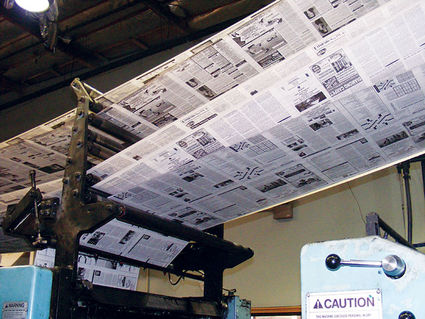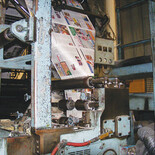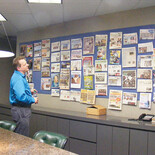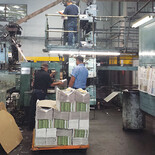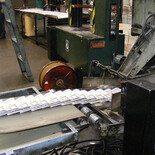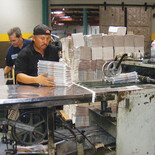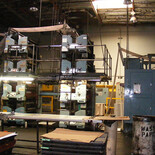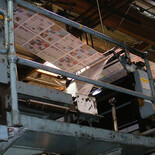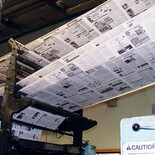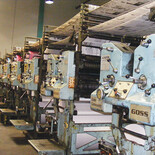How The Loop Gets Printed
Have you ever wondered where or how The Loop Newspaper gets printed? Recently Harriet and I from The Loop office had the opportunity to tour the Valley Printers plant in Sylmar where The Loop is printed. Valley Printers has been printing weekly, monthly and quarterly publications and advertising materials at that location for over 30 years.
On our arrival, we were greeted by General Manager Russell Sacks who told us that our latest issue of The Loop was in the last few minutes of being printed. We were escorted to the back of the huge warehouse-like building. Each area we passed through was filled with huge two story high web presses. Finally, in the last room, our printing job was still running through the presses. The paper was running through several sets of presses like thread through a sewing machine. Black and white pages were on the presses to the left and color on the presses to the right. The presses can print nearly 20 papers per second. Imagine, if a pressman discovers a small error in color during one of their many color checks, over a hundred papers can be printed before it can be corrected. Russell told us that The Loop can have as much as 20% waste that will be recycled. About that time, one of the workers ran over and gave each of us a copy for us to review. It looked great to us.
We noticed that when the presses were turned off at the end of a run, there were still hundreds of yards of printed paper remaining on the presses. We were told that all these pages remaining would be waste and be recycled. They also showed us stacks of papers and a trash bin of papers set off to one side. These were all rejects for various reasons from color to cutting. They would also be shredded and sent for recycling. Russell told us that the amount of recycling is due to the speed of the presses. When a job is set up, they run the press for several seconds, do a check for color and alignment and make an adjustment. They continue doing these checks until they are satisfied with the results. Even after the adjustments have been made, a copy of the paper is pulled for periodic checks to make sure color and registration stay consistent. Even with these checks, imperfections (registration issues) can slip by which is why we sometimes get a page that looks a little "off".
Two men were stationed where the stacked papers emerged from the press. They grabbed a stack and ran it to a banding machine. The 50-paper bundles were then stacked on a shipping pallet. We watched as the last few bundles came off the press and proceeded on with our tour as the crew moved our pallet to the shipping bay where we would pick them up later.
Russell lead us up to the second floor where we met Ray Geiger, the digital prepress manager, who receives all our print files when we send them in the middle of the night. Ray said that he lives in Bear Valley Springs but stays in the San Fernando Valley during the week. We were thrilled to learn that he was impressed with the quality of our print files. Next to the computer center is the conference room. One wall of the room is covered with copies of all the publications being printed by Valley Printers and, sure enough, there was The Loop among them.

Pat Doody
On the black and white presses, paper runs through the machines like thread through a sewing machine.
Back downstairs, and on our way to bring our vehicle in for loading, we passed yet another set of off-set presses. Russell told us that at the time of the 1994 Northridge earthquake, the company had an overstock of the giant rolls of paper used in printing newspapers. The giant stacks were stored right next to the presses. The earthquake caused the rolls to fall against the presses leaving very noticeable dents in the sides of the presses. When we saw the size of those dents, it was hard to imagine a weight that could cause that much damage. Russell added that they are no longer allowed to stack those rolls anywhere near the presses.
Our visit to Valley Printers was a real eye opener on a lot of levels. Aside from the amazing printing process on some of the biggest presses we have ever seen, we learned that today Valley Printers has one of the largest press configurations of its type in the world and among the most color capacity in Southern California. With their complete digital computer-to-plate capabilities and a high-speed T1 line for file delivery, there is not much more we could ask for from our printer.


